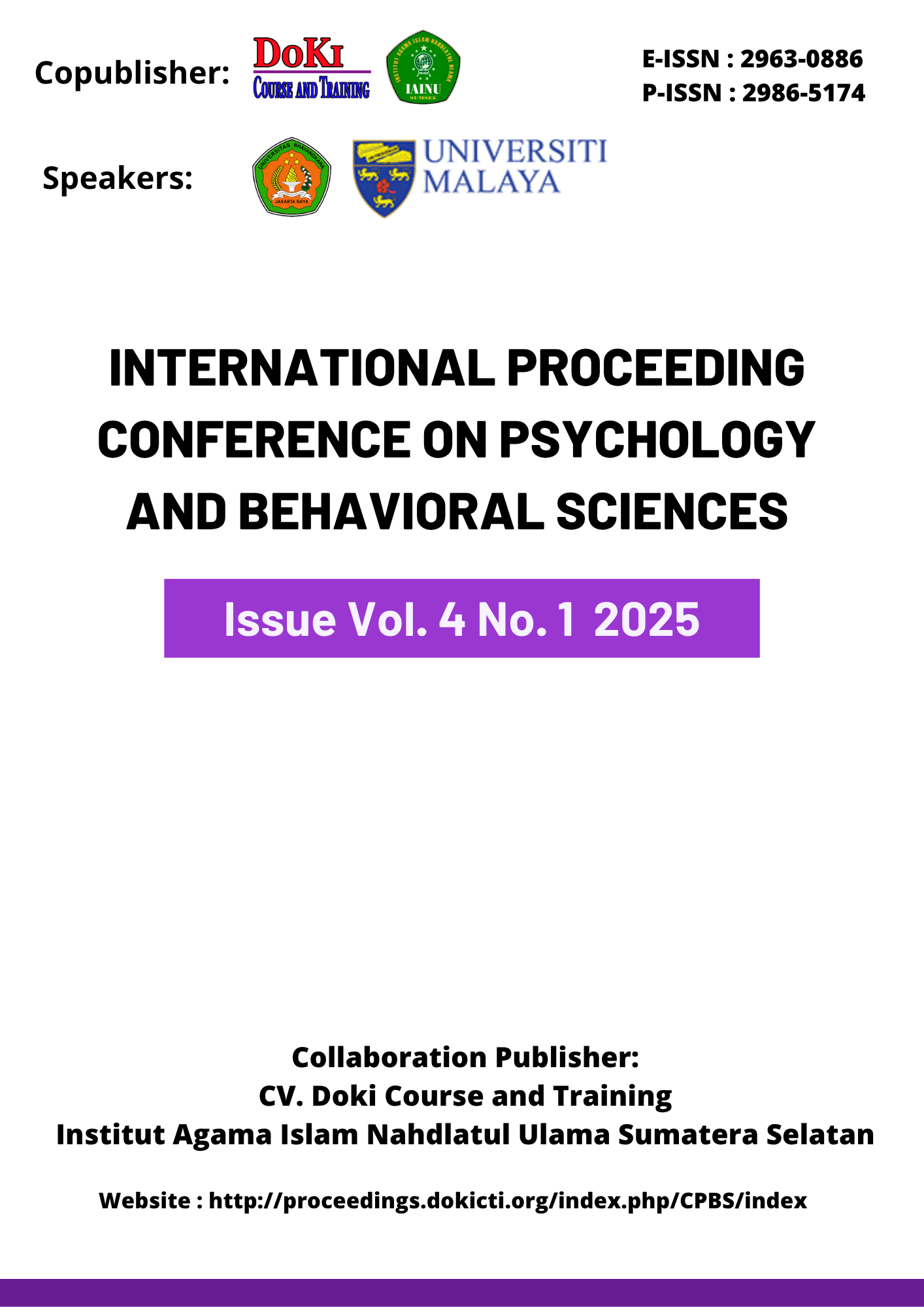The Relationship Between Religious Coping and Self-Acceptance in Parents Who Have Children with Physical Disabilities in The City of Aceh Besar and Banda Aceh
DOI:
https://doi.org/10.61994/cpbs.v4i1.212Keywords:
Religous Coping, Self Acceptance, Phsyical DisabilitiesAbstract
Development is the pattern of continuity and change in human capacities that occur throughout life. The majority of development focuses on growth, although it also covers decline (for example, physical ability may deteriorate with age). Disability is more than just an impairment; it is the result of the interaction of a person's limitations with their environment, whether physical or mental, and is a multidimensional phenomenon that includes bodily functions, activity limitations, barriers to participation, and environmental factors. The purpose of this study is to investigate the relationship between religious coping and self-acceptance in children with physical disabilities in Banda Aceh and Aceh Besar. This study uses a quantitative method with sampling based on proportionate stratified random sampling. The sample size was 208 parents. In this study, two scales have been utilized: the religious coping scale, which is based on aspects of Alfakseir (2011), and the self-acceptance scale, which is based on aspects of Berger (1952). The study's findings demonstrate a correlation coefficient of r=0.504 with p=0.000, indicating that parents of children with physical disabilities in Banda Aceh and Aceh Besar are more self-accepting. In contrast, the lower the religious coping, the lower the self-acceptance of parents with physically disabled children in Aceh Besar and Banda Aceh.
References
References
Adhara, H., Erika, E., & Wahyuni, S. (2023). Social Anxiety Levels among Adolescents at Social Child Welfare Institutions in Pekanbaru City. International Journal of Nursing and Health Services (IJNHS), 6(4), 246–256. https://doi.org/10.35654/ijnhs.v6i4.691
Aflakseir, A., & Coleman, P. G. (2011). Initial Development of the Iranian Religious Coping Scale. Journal of Muslim Mental Health, 6(1). https://doi.org/10.3998/jmmh.10381607.0006.104
Berger, E. M. (1952). The relation between expressed acceptance of self and expressed acceptance of others. The Journal of Abnormal and Social Psychology, 47(4), 778–782. https://doi.org/10.1037/h0061311
Brekke, I., & Alecu, A. (2023). The health of mothers caring for a child with a disability: a longitudinal study. BMC Women’s Health, 23(1), 639. https://doi.org/10.1186/s12905-023-02798-y
Carbone, P. S., Smith, P. J., Lewis, C., & LeBlanc, C. (2021). Promoting the Participation of Children and Adolescents with Disabilities in Sports, Recreation, and Physical Activity. Pediatrics, 148(6). https://doi.org/10.1542/peds.2021-054664
Carrasco, M. A., Delgado, B., & Holgado-Tello, F. P. (2019). Parental acceptance and children’s psychological adjustment: The moderating effects of interpersonal power and prestige across age. PLOS ONE, 14(4), e0215325. https://doi.org/10.1371/journal.pone.0215325
Doğan, M. (2016). Engelli Çocuğa Sahip Ebeveynler ile Sağlıklı Çocuk Sahibi Ebeveynlerin Dinî Başa Çıkma, Umut ve Sabır Düzeylerinin Karşılaştırılması. İnsan ve Toplum Bilimleri Araştırmaları Dergisi, 5(8), 3214–3214. https://doi.org/10.15869/itobiad.283094
Frontiers in Public Health. (2023). Global and regional prevalence of disabilities among children and adolescents: Analysis of findings from global health databases.
Garbóczy, S., Szemán-Nagy, A., Ahmad, M. S., Harsányi, S., Ocsenás, D., Rekenyi, V., Al-Tammemi, A. B., & Kolozsvári, L. R. (2021). Health anxiety, perceived stress, and coping styles in the shadow of the COVID-19. BMC Psychology, 9(1), 53. https://doi.org/10.1186/s40359-021-00560-3
Hamidah, F. (2020). The Relationship Between Religious Coping with Anxiety to Face the Free Period in Juvenile Inmates in Pekanbaru Children’s Special Development Institution. UIN Sultan Syarif Kasim Riau Pekanbaru.
Hurlock, E. B. (1980). Developmental Psychology Is an Approach Throughout the Life Span. PT. Gelora Aksara Pratama.
Juniarly, A. (2012). Peran Koping Religius Dan Kesejahteraan Subjektif Terhadap Stres Pada Anggota Bintara Polisi Di Polres Kebumen. Psikologika: Jurnal Pemikiran Dan Penelitian Psikologi, 17(1), 5–16. https://doi.org/10.20885/psikologika.vol17.iss1.art1
Karaca, A., & Konuk Şener, D. (2021). Spirituality as a coping method for mothers of children with developmental disabilities. International Journal of Developmental Disabilities, 67(2), 112–120. https://doi.org/10.1080/20473869.2019.1603730
Mikołajczuk, K., & Zielińska-Król, K. (2023). The Role of Religion in the Family Life of People with Disabilities: A Legal and Social Study. Religions, 14(11), 1371. https://doi.org/10.3390/rel14111371
Musendo, D. J., Scherer, N., Jepkosgei, J., Maweu, L., Mupiwa, A., Hara, O., Polack, S., & Patel, D. (2023). A Systematic Review of Interventions Promoting Parental Involvement in the Education of School-Aged Children with Disabilities. Australasian Journal of Special and Inclusive Education, 47(2), 123–139. https://doi.org/10.1017/jsi.2023.11
Nahar. (2019). Finding And Stimulating Children with Disabilities (Basic Guide for Parents, Families and Companions). Deputy for Child Protection.
Paragment, K. I., Exline, J. J., & Jones, J. W. (2013). APA handbook of psychology, religion, and spirituality (Vol 1): Context, theory, and research. (K. I. Pargament, J. J. Exline, & J. W. Jones, Eds.). American Psychological Association. https://doi.org/10.1037/14045-000
Primadi, O. (2014). Bulletin Window Data and Health Information Situations of Persons with Disabilities. Indonesian Ministry of Health.
Rahmawati, S. (2018). Pengaruh Religiusitas Terhadap Penerimaan diri Orangtua Anak Autis di Sekolah Luar Biasa XYZ. Jurnal Al-Azhar Indonesia Seri Humaniora, 4(1), 17. https://doi.org/10.36722/sh.v4i1.248
Ruan, Q.-N., Shen, G.-H., Yang, J.-S., & Yan, W.-J. (2023). The interplay of self-acceptance, social comparison and attributional style in adolescent mental health: cross-sectional study. BJPsych Open, 9(6), e202. https://doi.org/10.1192/bjo.2023.594
Santrock, J. W. (2011). Life-Span Development. Lifetimes (13th ed., Vol. 1). PT. Gelora Aksara Pratama.
Tokić, A., Slišković, A., & Nikolić Ivanišević, M. (2023). Well-Being of Parents of Children with Disabilities—Does Employment Status Matter? Social Sciences, 12(8), 463. https://doi.org/10.3390/socsci12080463
Utami, M. S. (2012). Religiosity, Coping Religiosity and Subjective Well-Being. Journal of Psychology.
World Health Organization. (2021, April 19). Disability in children and adolescents must be integrated into the global health agenda.
World Health Organization. (2023a). Disability and health.
World Health Organization. (2023b, September 15). New report highlights neglected health needs of children with developmental disabilities.
Downloads
Published
Issue
Section
License
Copyright (c) 2025 Devi Padiana, Safrilsyah, Cut Rizka Aliana, Bukhory Septa Yoga Harahap, Vira Nurul Mursalina Chasny

This work is licensed under a Creative Commons Attribution-NonCommercial 4.0 International License.



